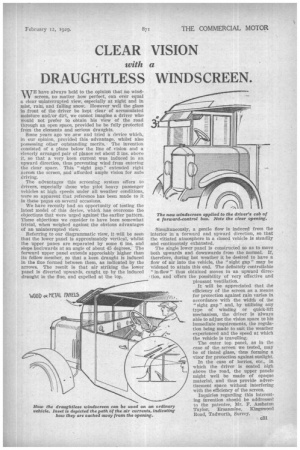E have always held to the opinion that no wind
Page 15

If you've noticed an error in this article please click here to report it so we can fix it.
V screen, no matter how perfect, can ever equal a clear uninterrupted view, especially at night and in mist, rain, and falling snow. However well the glass in front of the driver be kept clear of accumulated Moisture and/or dirt, we cannot imagine a driver who would not prefer to obtain his view of the road through an open space, provided he be fully protected from the elements and serious draughts.
Some years ago we saw and tried a device which, in our opinion, provided this advantage, whilst also possessing other outstanding merits. The invention consisted of a plane below the line of vision and a cleverly arranged pair of planes set about 3 ins, above it, so that a very keen current was induced in an upward direction, thus preventing wind from entering the clear space. This " sight gap" extended right across the screen, and afforded ample vision for safe driving.
The advantages this screening system offers to drivers, especially chose who pilot heavy passenger vehicles at high speeds under all weather conditions, were so apparent that reference has been made to it in these pages on several occasions.
We have recently had an opportunity of testing the latest model of this device, which has overcome the objections that were urged against the earlier pattern. These objections we consider to have been somewhat trivial, when weighed against the obvious advantagesof an uninterrupted view.
Referring to our diagrammatic view, it will be seen that the lower panel is approximately vertical, whilst the upper panes are separated by some 6 ins, and slope backwards at an angle of about 45 degrees. The forward upper panel extends appreciably higher than its fellow member, so that a keen draught is induced in the flue formed between them, as indicated by the arrows. The result is that air striking the lower panel is diverted upwards, caught up by the induced draught in the line, and expelled at the top. Simultaneously, a gentle flow is induced from the interior in a forward and upward direction, so that the vitiated atmosphere in a closed vehicle is steadily and continuously exhausted. The single lower panel is constructed so as to move both upwards and downwards from the normal. If, therefore, during hot weather it he desired to have a flow of air into the vehicle, the "sight gap" may be widened to attain this end. The definitely controllable " in-flow" thus obtained moves in an upward direction, and offers the possibility of very effective and pleasant ventilation.
It will be appreciated that the
efficiency of be, screen as a means for protection against rain varies in accordance with the width of the " sight gap" and, by utilizing any type of winding or quick-lift mechanism, the driver is always able to adjust the vision space to his immediate requirements, the regulation being made to suit the weather experienced and the speed at which the vehicle is travelling.
The outer top panel, as in the case of the screen we tested, may be of tinted glass, thus forming a vizor for protection against sunlight.
In the case of lorries, etc., in which the driver is seated high above the road, the upper panels might well be made of opaque material, and thus provide advertisement space without interfering with the efficiency of the screen.
Inquiries regarding this interesting invention should be addressed to the patentee, Mr. F. Assheton Taylor, .Ersanmine, Kingswood Road, Tadworth, Surrey.






























